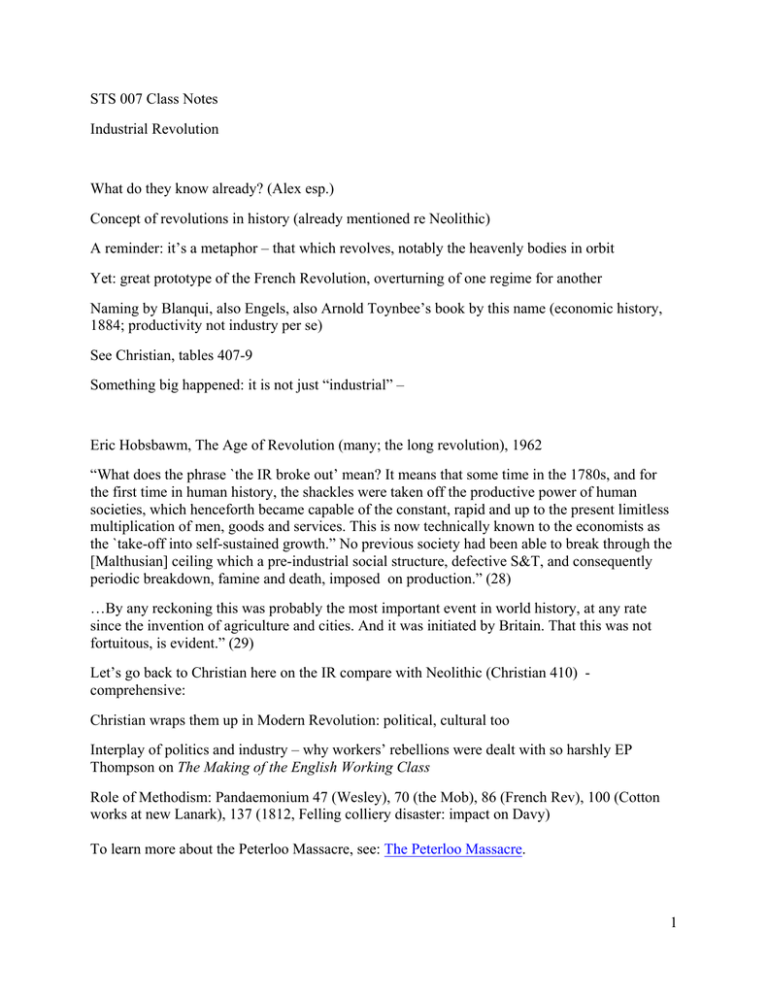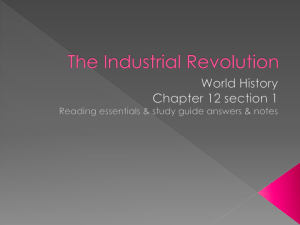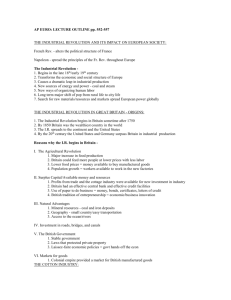STS 007 Class Notes Industrial Revolution
advertisement

STS 007 Class Notes Industrial Revolution What do they know already? (Alex esp.) Concept of revolutions in history (already mentioned re Neolithic) A reminder: it’s a metaphor – that which revolves, notably the heavenly bodies in orbit Yet: great prototype of the French Revolution, overturning of one regime for another Naming by Blanqui, also Engels, also Arnold Toynbee’s book by this name (economic history, 1884; productivity not industry per se) See Christian, tables 407-9 Something big happened: it is not just “industrial” – Eric Hobsbawm, The Age of Revolution (many; the long revolution), 1962 “What does the phrase `the IR broke out’ mean? It means that some time in the 1780s, and for the first time in human history, the shackles were taken off the productive power of human societies, which henceforth became capable of the constant, rapid and up to the present limitless multiplication of men, goods and services. This is now technically known to the economists as the `take-off into self-sustained growth.” No previous society had been able to break through the [Malthusian] ceiling which a pre-industrial social structure, defective S&T, and consequently periodic breakdown, famine and death, imposed on production.” (28) …By any reckoning this was probably the most important event in world history, at any rate since the invention of agriculture and cities. And it was initiated by Britain. That this was not fortuitous, is evident.” (29) Let’s go back to Christian here on the IR compare with Neolithic (Christian 410) comprehensive: Christian wraps them up in Modern Revolution: political, cultural too Interplay of politics and industry – why workers’ rebellions were dealt with so harshly EP Thompson on The Making of the English Working Class Role of Methodism: Pandaemonium 47 (Wesley), 70 (the Mob), 86 (French Rev), 100 (Cotton works at new Lanark), 137 (1812, Felling colliery disaster: impact on Davy) To learn more about the Peterloo Massacre, see: The Peterloo Massacre. 1 substructure? Culture too Also concept of “scientific revolution” – which Christian puts as part of “culture” Others emphasize more things that are peculiar to Britain Return to Margaret Jacobs and Lewis Mumford: cultural “pre-adaption” as well as geographic Clock: scientific attitude: Weber’s thesis on The Protestant Ethic and the Spirit of Capitalism Jan DeVries, “the industrious revolution” Contemporary analogies? Commercial cultures – “clash of civilizations” Readings in Pandaemonium on this: 125 (also 121, 85) Hobsbawm: Interest in science in England but most of all “private profit and economic development had been accepted as the supreme objects of government policy. For practical purposes the uniquely revolutionary British solution of the agrarian problem had already been found.” (31) Enclosure Acts 1760-1830 swept away “ancient collective economy of the village” – farming was for market agriculture: second agricultural revolution – enclosures, another tragedy of the commons (Garrett Hardin) – Karl Polanyi, The Great Transformation: how you think about the world privatization of world Pandaemonium 103, petition against enclosure Also return to agr as described in Christian text – how British agriculture was transformed by commercial capitalism (go to reading notes) Summary of pillars: new technologies (mechanization) reorganized business practices (not just factories) new sources of energy (from wood and water to fossil fuel, esp. coal) new materials (iron) relation to nature dominance of industry in national economy – decline of farming, silviculture, crafts – Mumford on “eotechnic” – wood, wind, water complex – wood above all, both as material and energy source (eotechnic, paleotechnic, neotechnic) 2 Concentric circles that become feedback loops Energy crisis of 18th century – running out of wood/charcoal (Haiti analogy) anyway - esp. when coke began to be used for ironmaking – importance of American forests (also for masts) – concept of “reverse salient” Traditional method of smelting iron mixed fuel and ore so they would react chemically – lime, wood, ore in a furnace Coal/coke as source of energy for iron-making – various efforts in 1600s – key is to keep coal separate from iron ore so latter is not contaminated with impurities in the coal esp. sulphur Abraham Darby 1709 – came into common use only in midcentury – no theoretical basis, just tinkering – “carbon” and “oxygen” unknown entities – larger blast furnace, higher temperatures – blast furnaces in Coalbrookdale – brittle - nails This produces pig or cast iron – useful for cast iron pots and kettles (thinner and cheaper) His son AD II built furnaces not far from Coalbrookdale that produced bar iron, which could be forged into other consumer goods converting it to wrought iron is “puddling” – pig iron made with smeltinig with coke was brittle, crumbled under a hammer – problem was to produce a pig iron that could be turned into wrought iron – this was through the “puddling” process using coal invented same year as Watt’s engine, 1784 – Cort: “stirring molten pig iron on the bed of a reverberatory furnace. The puddler turned and stirred the molten mass until, through the decarburizing action of air which circulated through the furnace, it became converted into malleable iron…contact between the metal and the raw coal that served as fuel as avoided…” (Singer IV 106) British iron production increased 10 times from 1700 to 1800 – before then had imported iron ore from Sweden and Russia – new processes meant they could use native ore – Britain became an exporter of bar iron as well as manufactured wrought iron consumer goods From 1788 to 1850, forty times To Learn more about the Bedlam Furnaces, see: Iron Furnace Ruins on Waymarking.com. Using iron for bridge building e.g. Shropshire, Abraham Darby III, 1778; Desolation of land: Part of the exploitive relationships mentioned by Thompson Pumping problem Newcomen’s engine invented 1712 – obscure ironmonger – idea of condensing steam in a cylinder and creating a partial vacuum so atmospheric pressure would drive the piston – cold water injected into the cylinder (from a cold water reservoir) to condense the steam – alternate heating and cooling of the cylinder 3 used in Newcastle area – first industrial landscape (Defoe on mountains and pits of coal) – clumsy, used so much fuel, but 57 in the area in 1767 Waterwheels remained main energy source in l8th c England – some tried to even out seasonal differences by using a Newcomen engine to pump back used water (i.e. had gone through the wheel) – a sort of mechanization of the water cycle Also various experiments to make it more efficient – e.g. Smeaton, doubling efficiency, same basic design Watt: story that he had applied Joseph Black’s theory of latent heat to arrive at separate condenser – “claims have been discredited” - Theory of steam engines only developed afterwards, by Sadi Carnot in 1820s – Reflections on the Motive Power of Fire (1824) Latent heat of steam (1757, Univ of Glasgow) – atmospheric steam (at 212) will heat six times its own weight of water (from room temperature to 212) without itself dropping in temperature at all condensing steam in separate vessel kept cold outside, so cylinder stayed hot much more efficient and also had rotary motion needed by industry – low pressure Pandemonium 51 idea 1765; patent 1784; partnership with Birmingham manufacturer Boulton – leased the machine, charged only for a percentage of the savings in the cost of coal over the Newcomen – developed reciprocating steam engine: rotary not pumping motion Flyball governor To learn more about Wyatt’s flyball governor, see: I SELL HERE, SIR, WHAT ALL THE WORLD DESIRES TO HAVE – POWER. first use of steam engine other than for pumping: 1776, to blow a furnace making iron: furnace enginers (Singer IV 104) so much cheaper, could be set up anywhere – 500 of them in Britain in 1800 mines much more profitable thereafter – remember Mumford again - Accidents: coal mining, safety lamp 1816 Relied on atmospheric pressure, so large – could go on a steamboat but not land Trevithick 1800 high-pressure design (reputed to be unsafe, and who cared at the mine shaft, so not much market: - tried to market it in Peru! (high altitude) – returned and put it on a track as a novelty 4 Pandaemonium 119, 130 Oliver Evans high pressure engine – performance based not on condensation but on immediate effect of steam pressure Railways first used, again, in Newcastle area – criss crossed by railway network - rails had long been used in mining areas – change from horses to steam power 1814 – George Stephenson, first steam locomotive Liverpool and Manchester 1830 Parkside is famous for being the station where William Huskisson MP was injured during the opening of the Liverpool and Manchester Railway. After alighting from the 'Northumbrian', which had stopped to take in water, Huskisson was struck by another locomotive and later died from his injuries. Pandaemonium 174 Boom in 1840s – you need iron to build the railways (steel still expensive) More demand for coal Textile production John Kay 1733, flying shuttle (he was initially a clockmaker) – cottage industry – remember “secondary” effects of Neolithic Rev - harassed by weavers, moved to France - improved weaving but then left a “reverse salient” in spinning thread Spinning depends on thumb and finger to give twist to make fibers into yarn – how to replace fingers? Idea of rollers Mechanization of spinning in 1760s and 1770s (before steam engine) as well as cylinder carding 1775 - Three stages: (Mokyr, Lever, 96-98) Arkwright introduced power-driven spinning frame in 1770s – called “water frame” or “throstle” – two pairs of rollers, moving at different speeds, separated by a distance equal to length of longest fiber to be spun (from spindle, on which is mounted a flyer, with rollers between it and the bobbin) – didn’t work with fine yarns Spinning jenny patented about the same time (James Hargreaves) – saw a spinning wheel fall on its side and continue to spin for some seconds – you could impart the twist not by moving fingers but by correct turning of the wheel itself – “The jenny twisted the yarn by rotating spindles that pulled the rovings from their bobbinis, with metal draw b ars playing the role of human fingers guiding the spun yarn onto the spindles by means of a faller wire. Instead of the single spindle turned by the spinning wheel, Hargreave’s machine used many spindles and thus allowed a large number of threads to be spun at the same time.” (Mokyr, Lever, 96)Low quality yarn, ,however, good only for weft, and adult spinners had to bend nearly double 5 Third: Mule, “ultimate spinning machine,” Crompton 1779 - “a carriage that was driven back and forth. In so doing, the spindles mounted on it turned quickly and together with the rollers imparted the twist on/ the yar, which could then be wound onn bobbins. At no stage was the yarn subjected to much strain, and thus the chances for breaking were much reduced.” Made cotton yarn much cheaper, stronger, and finer than ever – all cotton cloth now possible (Mokyr, 97-98) – takes dyes well, launders easily, ventilates well – lent itself to mechanization more than wool or linen (Mokyr, 100-02) now weaving was the reverse salient – Mechanically powered looms beginning 1785 – first water then steam – perfected 1792 by Cartwright – also cotton gin 1793 Productivity in cotton industry went up 200 times between 1764 and 1812 (proto-Moore’s law) 1813, 2400 power looms; 1833, 100,000 of them – in between Luddites, 1811-16, as hand-loom weavers lost their livelihood (same story as with “enclosures”) – would be repeated later when mechanized textile production was exported to e.g. India (Gandhi) Riots – burning of a mill using Cartwright’s power looms – remember fear of French revolutionaries (“communists” analogy) – Mokyr, Lever, p. 257: “In the sw of England, esp. in Wiltshire and Somerset, resistance to advances in the spinning and weaving of wool was strong and may have contributed to the shift of the center of gravity of the woolen industry to the northern counties.” Also “Captain Swing” riots vs. threshing machines in agr in s of England Urbanization of Britain: half of population as early as 1830; Germany only 1880; France not until 1930 Letting the country go: Repeal of Corn Laws, instituted 1815, in 1846 – to preserve high land values as they had inflated during the wars – landowners dominated in government – Manufacturing interests allied with common people (after Reform Act 1832) – Anti Corn Law League – manufacturers, merchants, bankers, traders – against protectionism, wanted free trade – succeeded in 1846 importing another kind of energy, to run people – sugar – what you eat and how you work Nature in the mine – wood to make shafts and corridors – pack animals – people – water Value of bison hides in providing leather belts for steam engines (before rubberized belting) – size, strength and quality better than cattle hides 6 Sugar cane – western Asia, learned in crusades – Cyprus – irrigation – islands off west African coast (Portuguese; plantation crop) finally Caribbean – 1513, a sugar mill built in what is now Haiti – then Brazil – irrigation, milling, burning cane trash – ceased to be an exotic luxury item – fuel for IR (Mintz: an agro-industry) – sweet tea, jam The nature of industrialization Fire and hell: John Martin engraving (railway tunnel) JWM Turner = To learn more about the Maidenhead Viaduct and Turner’s painting, see: The Web Gallery of Art. Exhilaration and regret are mingled with alarm; in a second we must leap aside to let the iron horse roar by. Crystal Palace celebration (glass and iron; greenhouse) Military implications – Wm McNeill on this Levee en masse Enabled Britain to beat Napoleon – everything came together in 1793 – England paid for the wars and also for coalitions – navy wall Revenues in 1793 of about twenty million pounds; 22 years later, nearly 80 millions (four fold, three fold discounting inflation) American cotton to England: went up 100 fold 1792-1800 – and four times that in 1810-11 (before war of 1812) – no other market then Civil War Democratization of luxury, including small arms American system of production – first applications in military armories (where cost was no object) – only slowly to civilian products, first sewing machines, wooden furniture, agricultural machinery such as reapers, bicycle – finally Henry Ford assembly linne – mass prod needed interchangeable parts, not the reverse – division of labor, business philosophy, large output, technological system all required Hobsbawm, again: “The Industrial Revolution was not indeed an episode with a beginning and an end. ..its essence was that henceforth revolutionary change become the norm. It is still going on…(p. 29) 7 Concept of “technological regimes” or waves of innovation -– main point is start of process of change that is so rapid and has such dramatic effects on human habitat (Read from Retooling on this) REVIEW AND PREVIEW OVERVIEW OF CHRISTIAN ENERGY, ORGANIZATION, DISSIPATION – SECOND LAW OF THERMODYNAMICS BEGINNING OF UNIVERSE, FIRST SIX CHAPTERS LEADING TO HUMANS – CHAPTER 15 (FUTURES) IS ABOUT ITS INEVITABLE AND IRREVERSIBLE DECLINE IN ORG. UNITES NATURAL AND HUMAN HISTORY KEY STEPS EMERGENCE OF HUMANS AS SPECIES CAPABLE OF COLLECTIVE LEARNING AGRICULTURE – SETTLEMENT, POPULATION PRODUCTIVITY, STATES MANY TO FEW TO ONE WORLD – A NEW STAGE FOR HISTORY NEW PRODUCTIVITY AND FOSSIL FUELS AS NEW ENERGY SOURCE – CHARTS (NOT LIKE FIRST CLASS) BREAKTHROUGH IN HISTORY: FOR THE FIRST TIME, INGENUITY OUTRAN POP. GROWTH THIS IS TOPIC OF CHRISTIAN CHAPTER 13 (NOTES ALLUDE TO STS.022 MATERIAL) HIS EMPHASIS ON NEW AGRICULTURAL PRODUCTIVITY: SUGAR STORY, ALSO AT HOME DISPOSSESSION AND ENCLOSURES – PAN. NO. 103, PETITION VS. ENCLOSURE – LOSS OF COMMONS (COWS AND SHEEP; HEART OF ENGLISH CHARACTER) 8 HE COVERS EMERGENCE OF NEW SOURCES OF ENERGY, MECHANIZATION OF PRODUCTION, ORGANIZATION OF PRODUCTION REVIEW: EMERGENCE OF BREAKTHROUGH MOMENT IN HISTORY GO TO SLIDE 15 THRU 38 – WHERE WE LEFT OFF – NEW LANDSCAPE DATES (WATT’S IDEA 1765; PARKSIDE, 1830) NOTE THE FEEDBACK LOOPS , OR CHAIN REACTIONS, AS CHRISTIAN DOES: IRONMAKING NEEDS MORE COAL - MORE COAL POSSIBLE BECAUSE OF STEAM ENGINES, WHICH WHEN REDESIGNED FOR HIGHER PRESSURE OTHER USES FOR STEAM ENGINES, E.G. IN BLOW FURNACES MAKING IRON COULD BE USED FOR TRANSPORTATION, THEN NEED MORE IRON (STEEL VERY EXPENSIVE) TEXTILES: A SEPARATE TRACK SECOND LARGEST EC SECTOR NEXT TO AGRICULTURE SPINNING AND WEAVING ARE THE TWO MAIN PROCESSES MAINLY WOOL IN ENGLAND (ENCLOSURES) – ALSO LINEN/FLAX – COTTON HARD TO WORK, FINER (TAKES TYES WELL, LAUNDERS EASILY) FLYING SHUTTLE AND WEAVING 1733 SPINNING - CONCEPT OF “REVERSE SALIENT” ROLLERS TO REPLACE FINGERS 9 ARKWRIGHT’S SPINNING FRAME – RUN BY WATER - PATENT DISPUTES – 1770 S JENNY – COULD OPERATE MANY SPINDLES – BUT UNCOMFORTABLE, AND LOW QUALITY YARN (2) MULE - HYBRID OF PRECEDING - ROLLERS AND SPINDLES – YARN UNDER LESS STRAIN, GOOD WITH COTTON BACK TO WEAVING MECHANIZATION WITH WATER THEN STEAM – BEGINNING 1780S, PERFECTED 1792 POWER LOOMS – CARTWRIGHT’S MILL BURNED VS. MR DALE’S COTTON WORKS AT NEW LANARK – Pan. No. 100 ORGANIZATION OF LABOR – PRODUCTIVITY WENT UP 200 TIMES 1764 TO 1812 WHAT ELSE WAS HAPPENING IN THAT ERA? FRENCH REV. – PANDEMONIUM NO. 86 COALITIONS VS NAPOLEON – 20 MILLION POUNDS REVENUE 1793, 80 MILLIONS 22 YEARS LATER (THREE TIMES MORE COUNTING INFLATION) WHAT HAPPENS IN US? EXPORTS OF COTTON TO GB UP 100 TIMES 1792 TO 1800, FOUR TIMES MORE BY 1811 – GLOBAL SYSTEM 19TH CENTURY FACTORIES IN US AND GB “THE MOB” – PANDEMONIUM NO. 70 – 1779, WEDGEWOOD – LUDDITES 1811-16 TECH’L UNEMPLOYMENT NEW LANDSCAPES 10 MINING TOO USE OF SUGAR AS STIMULANT – ALSO INCREASED DRAMATICALLY MINTZ – CONSUMPTION ROSE ENORMOUSLY 1650-1900 DUTIES LOWERED BEGINNING IN MID 19TH C, CONSUMPTION KEPT RISING – P. 177 – STIMULANT 18 LBS PER CAPITA EARLY 1800S, UP FROM 4 LBS. 1700 90 LBS PER CAPITA 1890S - READ P. 143 OTHER EXAMPLES OF GLOBAL SYSTEM: WOOD IN MINES FOR SHAFTS AND CORRIDORS, PACK ANIMALS BISON HIDES TO MAKE LEATHER BELTS FOR STEAM ENGINES, BEFORE RUBBERTIZED BELTING ( BETTER THAN CATTLE HIDES) USUALLY CALLED IR HE IS CALLING IN MODERN REV., IT IS LARGER: ALSO POLITICAL AND CULTURAL CHANGES FRENCH REV: IDEA OF PEOPLE CHOOSING RULERS (VOTING DAY) – NAMING THE IR AS ANALOGY CULTURE: SCIENTIFIC WAYS OF THINKING (IN NOTES) VISUAL ARTS: TURNER CRYSTAL PALACE 1851 – STOPPING POINT THREE WAVES? SPREAD TO F, US, G, BELGIUM LATER 19TH CENTURY: SECOND IR – TRANSFORMATION OF EVERYDAY LIFE 11 FOOD ELECTRICITY MATERIALS ESP. STEEL - BUILDINGS COMMUNICATIONS: TELEGRAPH, THEN TELEPHONE, RADIO, PHOTOGRAPHY LIGHT READING FOR NEXT CLASS MANIFESTO 1848 – TOP DOWN BOTTOM UP - SCHIVELBUSCH ON RAILWAY TRAVEL AND LIGHT CONTINUING ACCELERATION IN 20TH CENTURY – NEW SOURCES OF ENERGY E.G. NUCLEAR WEAPONS CHAPTER 14 IN CHRISTIAN ABOUT THIS – ALSO HERSEY’S HIROSHIMA 12 MIT OpenCourseWare http://ocw.mit.edu STS.007 Technology in History Fall 2010 For information about citing these materials or our Terms of Use, visit: http://ocw.mit.edu/terms.






